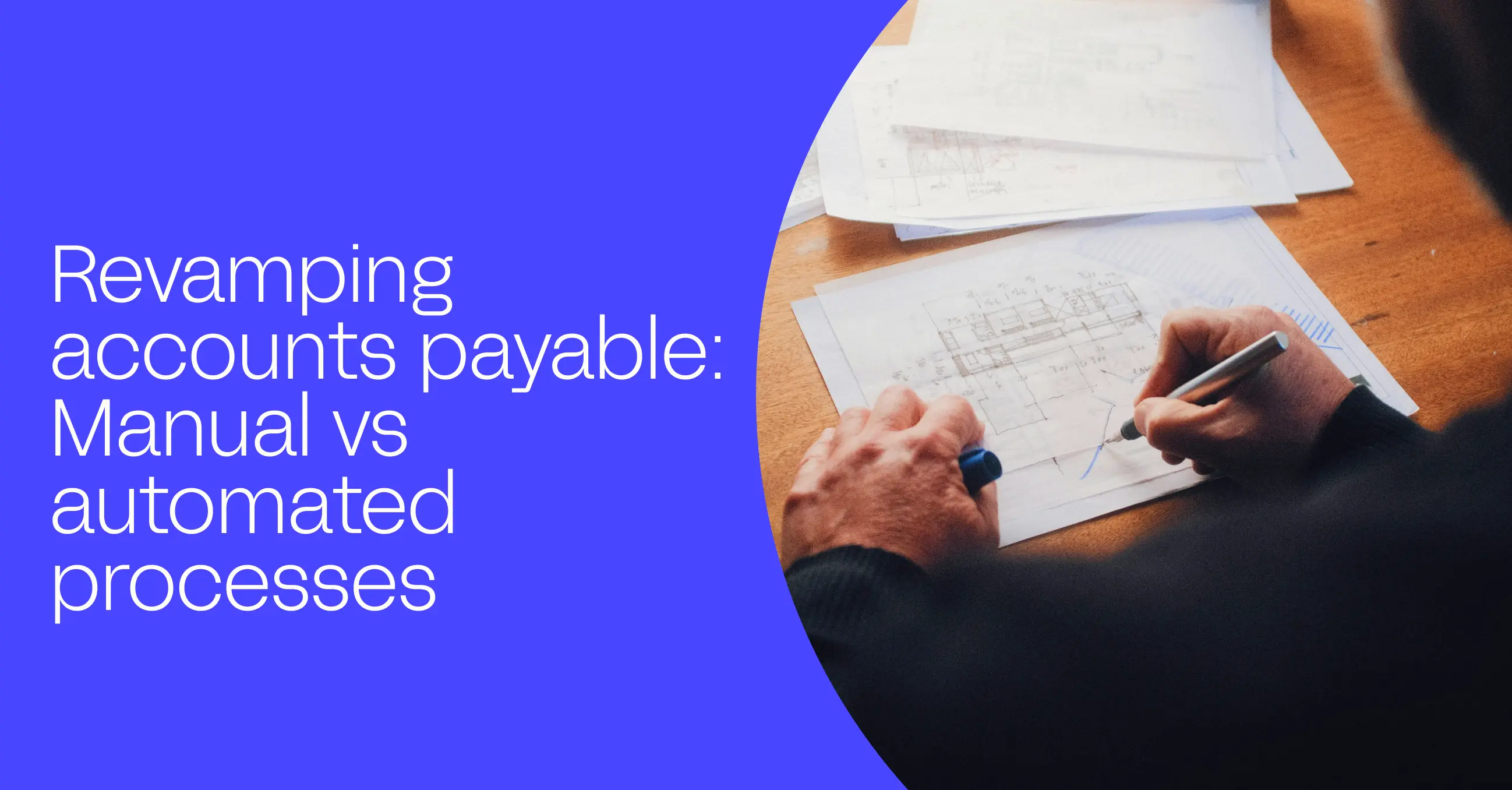How does ACH compare to a physical check?
Jo McCann
| July 20th, 2022
When it comes to B2B payment methods, two widely used options are ACH checks and physical checks. Below, we outline ACH checks and physical checks, highlighting their key purposes, similarities and differences. Toward the end, we offer an accounts payable solution that can help you streamline processes for these two payment methods.
What is an ACH check?
ACH checks, or Automated Clearing House checks, are a form of Electronic Funds Transfers (EFT payments), and they're more commonly referred to as ACH payments. Essentially, an ACH check is an electronic form of a check that is deposited directly into the recipient's bank account. With an ACH check, funds are transferred electronically without the need for a paper check, credit card, wire transfer or exchange of cash. Of course, this makes ACH checks an extremely convenient option for individuals or organizations sending funds to one another.
Some common examples of ACH check payments include:
Direct deposits. Whether we realize it or not, many of us receive ACH check payments every month. This is because an ACH direct deposit is simply any kind of electronic transfer made between a business or government to a consumer. Paychecks, employer-reimbursed expenses, government benefits, tax refunds, annuity payments and interest payments are all examples of ACH direct deposits.
Direct payments. Direct payments are another example of ACH check payments. When individuals send money to friends or family on social payment apps like Venmo, Paypal or Zelle, they're using ACH payments. Businesses sometimes use direct payments to pay their vendors, too. For example, Paypal is often used to pay contractors or freelancers.
Physical checks: A quick background
In comparison to ACH checks, a physical check is a written, dated and signed piece of paper that directs a bank to pay a specified amount of money to a payee. The person or entity that writes the physical check is referred to as the payer or drawer. The person or entity to whom the check is written is the payee. Checks can be exchanged for cash, and the payee doesn't need a bank account to receive the payment.
Checks have been around for a long time — the ancient Romans used them and the oldest American check dates back to the 1790s. Because of their ease of use and reliability, checks are still widely used, especially with B2B payments.
What is the difference between an ACH check and a physical check?
While ACH checks and physical checks share many traits, they also have some key distinctions. We highlight the common differences between ACH checks and physical checks below.

Is an ACH check faster than a traditional physical check?
Yes, receiving payment and processing an ACH check is faster than a physical check. ACH checks are faster than traditional physical checks because ACH checks are handled completely electronically and can be automated.
In comparison, physical checks are traditionally processed by people rather than computer systems, which leads to longer processing times. A physical check has to either be mailed to the recipient or the recipient has to pick it up themselves from the payer. Overall, the labor in creating and sending a physical check adds to the processing timeline and affects how quickly the payee can access their payment.
When sending an ACH check, you can choose from the following delivery speeds:
ACH Same Day: Processed by end of business day
ACH Next Day: Processed within 1 business day
ACH Expedited: Processed within 2 to 3 business days
ACH Standard: Processed within 4 to 5 business days
Physical checks can be more expensive than ACH checks
Along with the longer processing time associated with traditional physical checks, obtaining physical checks can also prove to be more expensive than ACH checks. According to AFP's 2022 Payments Cost Benchmarking Survey, the median cost of initiating and receiving an ACH check payment for all businesses falls between $0.26 and $0.50. In comparison, according to Nacha, receiving physical checks has a median cost of around $1.01 to $2.00 for all businesses. To issue a paper check, it can cost anywhere between $4 to $20. Based on these stats, it's clear that ACH check payments are just a fraction of the cost of physical checks.
Is an ACH check safer than a traditional physical check?
While both ACH checks and physical checks are safe processes, ACH checks are slightly safer than physical checks. For example, physical checks might get lost in the mail and can be susceptible to fraud if they're intercepted by someone other than the recipient. In comparison, ACH checks go straight to the recipient's bank account with little to no chance of interference or fraud.
Some of the key similarities found between both ACH checks and physical checks are:
Low fees. For both ACH and check payments, the fees associated remain relatively low, far lower than the interest and fees associated with using credit cards and even debit cards for business payments.
Great for domestic payments. If you are conducting business solely in the U.S., both ACH and checks can be used for payments with ease. Some ACH payments can now be made with a same-day direct deposit of funds. For businesses that work directly with contractors and can write a check on the spot, payments are made in real time.
The major pro and con of physical checks to the payee
Pro: Physical checks can be exchanged for cash: Probably the biggest benefit to using physical checks for payment is that a recipient can use the check to immediately withdraw cash. If the physical check is taken to the issuer's bank, there may not even be a processing fee, though the amount that can be withdrawn same-day may be limited. Cashing a check in this way does not require the recipient to have a bank account, and while this is seen as a low-barrier payment method, it also makes it susceptible to fraud. Once a check has been cashed, recovering lost funds requires legal action and does not guarantee you will get your money back.
Con: Physical checks can be lost, delaying payment. While a check can be stopped by contacting the issuing bank to prevent fraud, the time delays of stopping a check and reissuing a check can take weeks, depending on bank policies and AP/AR procedures.
There are more pros than cons associated with using ACH checks
While physical checks do have some benefits, they also have drawbacks. In comparison to physical checks, ACH checks have many more benefits than they do drawbacks.
ACH checks can be more secure. Each paper check that is issued has sensitive bank account information, including account numbers and routing numbers. For payments made through the ACH network, that sensitive information only needs to be provided on the first instance, at which time the information is encrypted and stored. This makes ACH a beneficial option for recurring bill payments like utility bills, rent or mortgage and payroll — even suppliers that are being used frequently with multiple invoices processing regularly.
ACH checks are direct deposit and fully electronic. ACH checks do not require a clerk or manual handling to process, which significantly reduces processing times and minimizes errors. The reduction in processing time means that businesses can process payments at a much higher volume, at the same time making direct payments to employees and vendors with a few clicks.
Any purchase made using ACH is conducted completely within a digital matrix. Funds are withdrawn directly from an issuing payer, known as an ACH debit. They are then held by the automated clearing house network for batch processing and then finally deposited into the recipient's bank account as an ACH credit.
ACH checks leave a paper trail for easy audits. Being able to track payments is essential to accounting best practices to complete audits and correct errors. A paper check may change hands a number of times before it ever becomes a deposit. These touch points introduce human error at each occurrence without any real ability to backtrack.
ACH checks and physical checks be used domestically and internationally
When it comes to international physical checks, most United States banks will accept them. Receiving payments, however, can turn into a lengthy process because most banks will not deposit funds until the foreign bank has paid the U.S. bank, which can take a number of weeks.
In comparison, international ACH checks have a variety of rules and regulations as there is no globally accepted ACH system. For example, in the United States, the system is the National Automated Clearing House Association or Nacha. Throughout Europe, the primary ACH system is the Single Euro Payments Area or SEPA. In order for international ACH checks to be transferred from the United States, they must follow all of Nacha's rules. These rules include:
Providing necessary identifying information for each party in the transaction.
Having gateway operators classify any payments to and from financial institutions outside the country.
Once an international ACH check is deemed to have met all of Nacha's regulations, it usually takes one to five days to be deposited.
Learn more: How international ACH works
Send both ACH checks and physical checks with Routable
Whether you're sending ACH checks or physical checks, Routable has you covered. Leverage ACH checks or fill out physical checks and sign them through our platform, and we'll take care of printing and sending them to your vendors and contractors to save you hours of time.
Routable creates a unified view of your payables with accounting integrations to Xero, QuickBooks Online, NetSuite or Sage Intacct and grows with you as you scale to mass payouts.
If you're ready to take the leap, chat with a Routable team member by requesting a demo.
Recommended Reading

Accounting
What is payment automation?
From fraud detection to reducing manual data entry, automation can help your team be more efficient and focus on much more crucial tasks than filing papers.

Accounting
Revamping accounts payable: Manual vs. automated processes
Learn how transitioning from manual to automated processes can revolutionize your Accounts Payable department while avoiding potential pitfalls.
